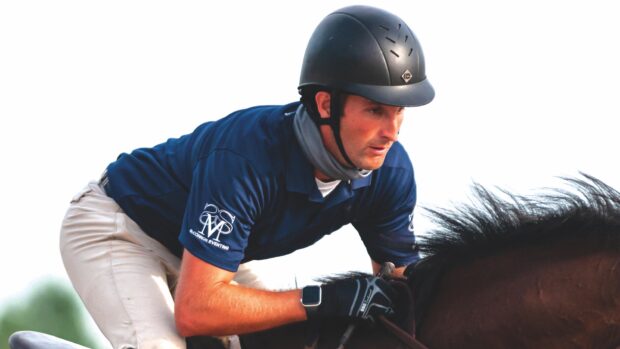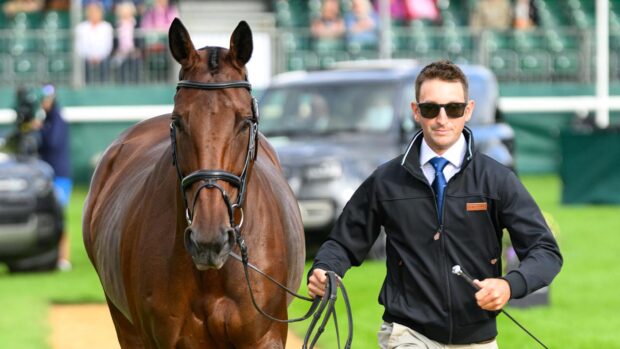An international showjumper who used hind boots with “sharp spikes” on a horse in a “clear case of abuse” has been banned for a year, in the first case of its kind.
Ukrainian rider Andre Schröder was competing 13-year-old gelding Allegro at the CSI* in Samorin, Slovakia (6–9 May). Before the grand prix, hind boot control was performed on all horses. When the rider’s groom handed Allegro’s left boot to the assistant chief steward, it was found to have sharp pressure points on the inside. The right boot had the same points.
Schröder was told the boots were prohibited, and may cause an abuse of horse offence owing to the “dangerous” pressure points, which would cause “excessive pain” and discomfort. The steward said Schröder argued that the boots were “OK”, and he had been allowed to jump in the ranking class using them. He claimed he had bought the boots with the points inside.
The chief steward said the boots contained sharp objects, which caused pain to his finger when he pushed on them. When he spoke to Schroder, the rider’s reaction was “very clear” that the boots were “a normal type of hind boots which he used in many competitions”.
Photographs showed 11 sharp pressure points, which would sit on the cannon bone, and if the horse hit a pole the points would cause excessive pain and discomfort.
The boots were investigated by the president of the ground jury, who confirmed there were holes on the inside of the boots and in each of the holes were “sharp spikes”.
The boots were returned to Schröder’s groom, following which Schröder claimed they were not his; he had found them on the way to the warm-up arena and used them “just to protect his horse”. Following his jumping round, according to the chief steward, Schröder stated the horse didn’t need the boots as he had “jumped well”.
Schröder was given a yellow warning card for abuse of the horse and on 8 June FEI disciplinary proceedings were opened against him. He replied to the FEI on 17 June and said when he got on Allegro that day, boots had not yet been put on. He asked his grooms to get boots and put them on – but said he did not look at the boots.
The FEI told the Tribunal that by using the boots Schröder engaged in abuse of the horse, an abusive training method that caused fear, and used the horse’s equipment to inflict pain and discomfort. It was claimed the location of the sharp points were “not coincidental” and horses’ distal limbs are particularly sensitive owing to the lack of soft tissue coverage.
An expert witness statement from FEI veterinary manager Gonçalo Paixão further explained limb sensitivity and said trauma of the skin and tissues will trigger an inflammatory response and acute pain.
The FEI added that to avoid pain caused by the boots, the horse will “over-jump”. The use of such boots presents an abusive method to make horses jump higher and more carefully with the intention of competitive advantage, and the “sole purpose” is to inflict pain on a horse in an attempt to force it to perform “abnormally”.
The FEI noted Schröder’s intentional use of the boots by his comment to the chief steward that his horse “doesn’t need these boots, he jumped well”, indicating he knew fully what effect the boots would have, and had Allegro knocked jumps down, he would have “needed” them to improve his performance.
On the day Schröder claimed to officials “with no remorse” he had used the boots many times. It was clear to the FEI the abuse was a recurring event that should be considered as an aggravating circumstance.
To determine sanctioning, the FEI reviewed previous case law regarding horse abuse, but confirmed Schröder’s case was the first case of abuse carried out with abusive hind boots.
In a decision issued on 29 September, the FEI Tribunal agreed it was Schröder’s decision to use the boots, but it was unclear how often he had used them. The Tribunal also agreed that Schröder’s claims he had never seen the boots, or did not know which ones the grooms put on, were false.
The ground jury was “applauded” for prompt sanctioning at the competition, but the Tribunal wanted to highlight that “additional appropriate action” could have taken place at the time. The Tribunal considers it “regrettable” the matter was not dealt with more severely on the ground, taking into account the seriousness of the violation and the sanctions available.
As well as issuing warnings and yellow cards, the ground jury may impose a fine of up to 2,000 Swiss francs (£1,588) and eliminate or disqualify a rider and/or horse.
The Tribunal said Schröder gave various, inconsistent explanations during the competition – and in his response of 17 June, which included a reference to personal difficulties with his partner which the Tribunal said were “irrelevant” and “no excuse”.
“The Tribunal considers the respondent’s behaviour amounts to an act of clear abuse of horse as well as the maltreatment of horses. Such behaviour also amounts to the most severe offences that can be committed in the context of equestrian sport. The Tribunal deems the respondent’s actions were deliberate as it was confirmed by the respondent the boots needed to be either purchased or home-made in advance,” read the decision.
“The respondent confirmed to officials, with no remorse, that he had used the boots already many times before in competition. Taking into account the respondent is an experienced rider who has been participating in the most high-profile competitions, he should be a role model and ensure compliance with the rules.”
The Tribunal suspended Schröder for 12 months, based on evidence and the mitigating circumstances; he had no disciplinary history and it was unclear how much he had used the boots. His results from the competition were disqualified, he was fined 5,000 Swiss francs (£3,971) and must pay 2,000 Swiss francs (£1,588) costs. He can appeal to the Court of Arbitration for Sport within 21 days of the Tribunal’s decision.
You might also be interested in:

Top rider’s 10-year ban for ‘deliberate, methodical and repetitive’ electric spur use
The rider said he intends to appeal immediately to the Court of Arbitration for Sport.

Record ban for endurance rider who committed three doping offences in 12 months

Subscribe to Horse & Hound magazine today – and enjoy unlimited website access all year round
Horse & Hound magazine, out every Thursday, is packed with all the latest news and reports, as well as interviews, specials, nostalgia, vet and training advice. Find how you can enjoy the magazine delivered to your door every week, plus options to upgrade your subscription to access our online service that brings you breaking news and reports as well as other benefits.




